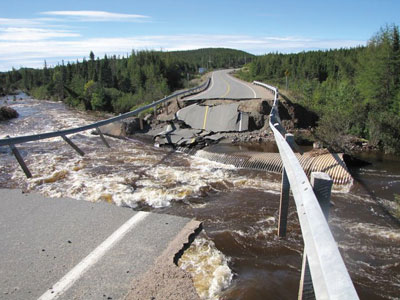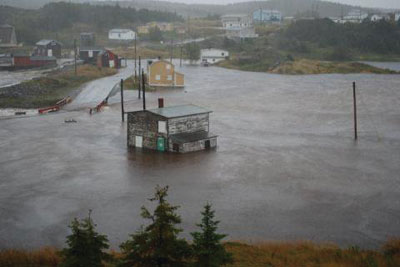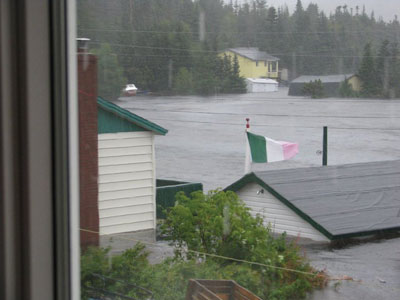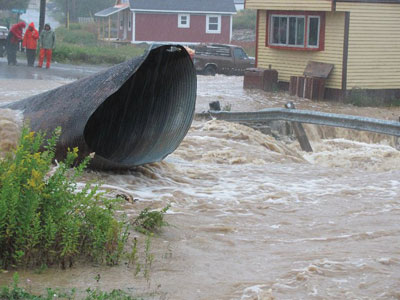
News
Hurricane havoc
CURRENT ISSUE
Hurricane havoc
Volunteers faced multiple challenges when Hurricane Igor dumped more than 200 millimetres of rain on the eastern part of Newfoundland in less than 24 hours.
January 5, 2011
By Kirk Squires
On the morning of Sept. 21, fire departments across eastern Newfoundland were tasked with protecting the public from firefighters’ traditional ally: water.

|
| Roads in several Newfoundland communities, including this one in Port Rexton, were washed out by the force of the water rising around them during Hurricane Igor in September. (Photos courtesy Fire and Emergency Services – N.L.)
|
In fewer than 24 hours, Hurricane Igor dumped more than 200 millimetres of rain on the eastern portion of the island and battered the region with hurricane-force winds. The hardest-hit areas ran from the Burin Peninsula on the province’s southern coast to the Bonavista Peninsula in the north.
 |
|
| Volunteer firefighters used available resources to rescue residents in the aftermath of Hurricane Igor. Melrose, N.L. (above), near the eastern tip of the Bonavista Peninsula, was among several flooded regions. |
|
 |
|
| The community of Trouty, N.L., was among the worst hit by Hurricane Igor. |
|
 |
|
| The magnitude of the damage from Hurricane Igor, which challenged first responders, is evident in this image from Elliston, N.L. Advertisement
|
More than 150 roads and bridges were washed out, close to 80 communities were left isolated and the storm claimed the life of Allan Duffet of Britannia, Random Island, when the road on which he was standing collapsed. The damage to infrastructure and personal property was widespread, with initial cost estimates in excess of $100 million.
Through the height of the storm, and in the days that followed, it was the local fire departments – the vast majority of them volunteer – that provided unwavering first response service to residents. Clarenville, approximately 180 kilometres west of St. John’s, was the first community to officially declare a state of emergency. The fire department was one of the first groups to jump into action.
“We immediately started our emergency centre and made the calls to get the evacuation centres open,” says Fire Chief Cory Feltham. “First and foremost was public safety. We knew the areas that were in danger so evacuating the people in those areas was the first priority.”
Whether it was for downed power lines, uprooted trees or flooded basements, people called the fire department first. “There were so many calls at the same time; you had to prioritize. A tree across the road wasn’t as urgent as a power line down. Public safety was the priority,” says Feltham. “Make sure everyone is safe; everything else can be replaced.”
Isolated
The first step in responding to any emergency is getting to the victim. That was the challenge for departments in areas such as Southwest Arm and along much of the Bonavista Peninsula, where fire departments serve multiple communities.
Located in Hodge’s Cove, the Southwest Arm Fire Department serves eight communities – Long Beach, Hodge’s Cove, Caplin Cove, Little Hearts Ease, Butter Cove, Gooseberry Cove and Southport – stretched along the coast. And according to Southwest Arm Asst. Chief Randell Meadus, every one of those communities was cut off by washouts. In his 26 years as a firefighter, Meadus has seen every kind of emergency, but admits this is the first time he witnessed this level of widespread devastation. But, he says, the firefighters took it in stride. “It wasn’t a big panic. Right out of the gate, we figured out what we had to do, get it in action, get the gear in place and start from there.”
In one instance, the department responded to a call involving a woman requiring immediate medical assistance. The only way to get her to hospital was to leapfrog over and around the numerous washouts. The first step was getting her out of the community by boat. Rather than risk any discomfort to the patient, they didn’t bring her to the boat, they brought the boat to her.
“We put the boat on the trailer and towed the boat and trailer into the patio, laid her into the boat on a stretcher from the deck, and launched the boat into the water to transport her across the harbour,” explains Meadus.
On the other side, she was stretchered into a waiting van and driven to the next washout, brought across that chasm to another waiting van. That van brought her to another local wharf where she was loaded aboard another boat to get past the last major washout. “We got her to Long Beach where we could get her into an ambulance and transported to hospital.”
At one point, the Southwest Arm department had three ambulances coming out of Clarenville into Long Beach for patients.
“We had a man with a massive heart attack, the lady we had to put on the boat and another lady who fell down and broke her collarbone and ribs. They all got to the hospital,” says Meadus. Unfortunately, despite the efforts of the firefighters, the heart attack victim didn’t survive. “The guys did everything humanly possible to bring him back.”
When not responding to emergency calls, the Southwest Arm department, like so many others, was co-ordinating relief efforts. “We had a meeting with the owners of local shops and they made an order of what they needed,” explains Meadus. “Trucks came to Long Beach and we had the boats in place to deliver goods to the stores.”
The department, along with local residents who offered their assistance, did whatever was needed. Meadus says two firefighters volunteered to go by boat in very high winds to get crucial heart medication to a woman in Hodge’s Cove.
Meadus has high praise for the members of his department. “The phone and radio I was connected to would have been useless if I didn’t have the crews able and willing to respond.”
Sense of community
Along with providing command services throughout the storm, local fire departments were a haven for those unable to get home. The Port Rexton Fire Department was home to 22 people – local residents and holiday travellers – stranded by washouts. Even the department’s own vehicles were rendered useless.
“Neither could go more than a mile in either direction because of road washouts. The equipment carrier stood guard at the 30-foot gorge that used to be a small brook and bridge to the east of the fire hall.” Instead, the department relied on personal ATVs and four-wheel drives that could navigate around the washouts. “We knew by noon we were in trouble, so the call went out,” says firefighter Sarah Morgan.
According to Morgan, the Port Rexton Fire Department is a family affair. Tracy and Terry Ricketts, both members of the department, were unable to reach their home. The couple and their 10-year-old daughter Victoria spent that first day and night serving their community and the 22 people who found themselves cut off from the rest of the world. In the days that followed, firefighter David Ellis organized a traditional Newfoundland kitchen party, complete with a Screech-in, to lift spirits. The following night saw a candlelit turkey dinner for the fire department’s guests.
Morgan says throughout the response efforts to Hurricane Igor, members took note of how they could be more prepared if a similar emergency were to arise again. “As a fire department, we are always trying to improve, so we are thinking of putting together a stash of blankets and pillows. Just general things you need. We had people there for six days,” she says. “We were lucky though. We had access to a local store so we were able to get things like toothbrushes. And we went to the school to borrow the gym mats so people could have something to sleep on other than the concrete floor.”
While taking care of those stranded by the storm, the fire department continued to answer calls and spent long hours pumping out basements, clearing away felled trees and bringing food and medications to those stranded at home. They also co-ordinated with other departments, such as Princeton, to get supplies to other stranded communities by rerouting through logging roads, side roads and paths on ATVs.
“At one point, everyone who lived in the surrounding communities, if they could get to us, could get a hot meal. We were also putting together little meals that we could bring out. That’s what it is all about,” says Morgan.
The aftermath
Many of the volunteer fire departments involved in first response to Igor are now in the process of looking at the lessons learned. Several of those departments have been impacted heavily on a financial scale. Igor put departments such as the Summerville-Princeton-Southern Bay Volunteer Fire Department in the red.
Morgan says the Port Rexton department was also impacted financially, but adds that the people who found shelter through the storm were quick to offer donations when the ordeal was over. “We had quite a bill because we provided food and gas. Right now we have $1,600 in donations and that is much needed because our PPE is getting pretty old.”
For some other departments, the emergency hit closer to home. The Five Coves Fire Department on the Bonavista Peninsula was evacuated when water flooded the fire hall. Members had to rush to get apparatuses and firefighting gear and equipment to higher ground at the community centre.
Through Igor, fire departments and volunteer firefighters were the first to respond to protect their communities and local residents. While firefighters across the region affected by Igor are not looking for thanks, they do carry a strong sense of pride in being volunteer firefighters and being the first to respond when their community requires assistance. That sense of pride is apparent in the words of Sarah Morgan.
“Any volunteer fire department is the hub of the community in so many ways. It’s why I joined.”
Kirk Squires is a freelance writer in Clarenville, N.L.
Print this page